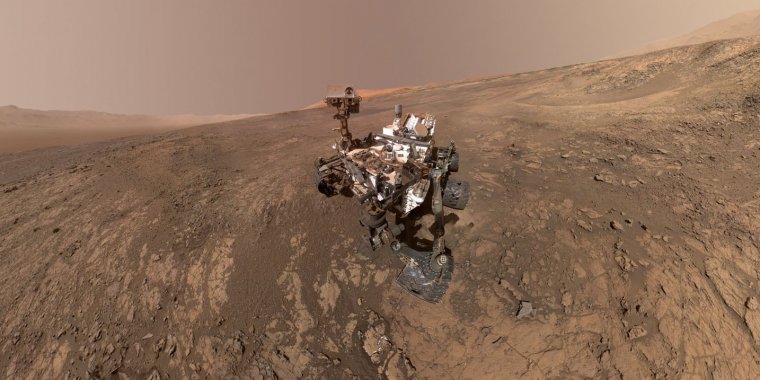| News / Space News |
Asteroids, Hydrogen Make Great Recipe for Life on Mars
A new study reveals asteroid impacts on ancient Mars could have produced key ingredients for life if the Martian atmosphere was rich in hydrogen. An early hydrogen-rich atmosphere on Mars could also explain how the planet remained habitable after its atmosphere thinned.

NASA's Curiosity Mars rover on Vera Rubin Ridge. Image credit: NASA/JPL-Caltech/MSSS
These key ingredients are nitrites (NO2) and nitrates (NO3), fixed forms of nitrogen that are important for the establishment and sustainability of life as we know it. Curiosity discovered them in soil and rock samples it took as it traversed within Gale Crater, the site of ancient lakes and groundwater systems on Mars.
To understand how fixed nitrogen may have been deposited in the crater, researchers needed to recreate the early Martian atmosphere here on Earth.
The study, led by Dr. Rafael Navarro-González and his team of scientists at the Institute of Nuclear Sciences of the National Autonomous University of Mexico in Mexico City, used a combination of theoretical models and experimental data to investigate the role hydrogen plays in altering nitrogen into nitrites and nitrates using energy from asteroid impacts.
In the lab, the group used infrared laser beam pulses to simulate the high-energy shockwaves created by asteroids slamming into the atmosphere. The pulses were focused into a flask containing mixtures of hydrogen, nitrogen and carbon dioxide gases, representing the early Martian atmosphere.
After the laser blasts, the resulting concoction was analyzed to determine the amount of nitrates formed. The results were surprising, to say the least.
The big surprise was that the yield of nitrate increased when hydrogen was included in the laser-shocked experiments that simulated asteroid impacts. This was counterintuitive as hydrogen leads to an oxygen-deficient environment while the formation of nitrate requires oxygen.
However, the presence of hydrogen led to a faster cooling of the shock-heated gas, trapping nitric oxide, the precursor of nitrate, at elevated temperatures where its yield was higher.
Why were the effects of hydrogen so fascinating? Although the surface of Mars is cold and inhospitable today, scientists think that a thicker atmosphere enriched in greenhouse gases such as carbon dioxide and water vapor may have warmed the planet in the past.
Some climate models show that the addition of hydrogen in the atmosphere may have been necessary to raise temperatures enough to have liquid water at the surface. (NASA)
YOU MAY ALSO LIKE



